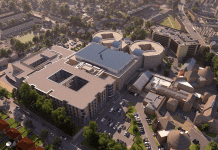Nick Blake, BSRIA’s principal FM consultant discusses climate change, the coronavirus pandemic and the fourth industrial revolution are all driving changes in the industry
These changes in the design, operation and maintenance of buildings come with consequences. The following trends have developed:
- Demand for comfort-cooling as the UK has had the hottest 10 years in recorded history within the last 20 years.
- Adoption of connectivity and remote working technologies, driven by national lockdown.
- Demand for new ventilation systems and independent verification of existing ones to ensure effectiveness in reducing the spread of respiratory-syndrome viruses (MERS, SARS, Covid-19 and future ones) and to improve indoor air quality (IAQ).
- The fourth industrial revolution, which is reshaping almost every sector in the country and the world.
As building technology evolves, facilities managers are increasingly working with combinations of hardware, software and human resources. Robotics, artificial intelligence, nanotechnology, biotechnology, fifth-generation wireless technologies (5G), 3D printing, virtual and augmented reality, and the internet of things (IoT) are finding their way into buildings, increasing system complexity and management challenges.
The increase in complexity of buildings with respect to design, M&E services, and use, emphasises the need for well-documented and accurate operations and maintenance manuals. BSRIA guide BG 79/2020 Handover and O&M Manuals is designed to help achieve this accuracy and comprehensiveness. This guide complements several other BSRIA publications, including BG 26/2011 Building Manuals and Building User Guides.
Building and building services documentation content has not changed greatly in the last decade. What has moved on considerably are the delivery methods.
Digital O&Ms, building manuals and building user guides
With backup systems such as solid-state drives (SSDs), solid-state hybrid drives (SSHDs) and other portable storage equipment, traditional backup tapes/discs, and offsite cloud storage, version-controlled copies of O&M manuals can be kept secure.
Further controls could be possible via secure-by-design, decentralised or distributed ledgers — some using blockchain technologies, accessible by managers from anywhere with a secured network, and by engineers and technicians on the “shop floor”. Unauthorised access can be prevented by securing the network with a series of private keys or virtual private networks, and for the most ambitious, a decentralised blockchain network. Digital documents offer improved indexing and searching functions, enabling users to identify component characteristics, manufacturers, and details of spare parts quicker.
While these technologies are more common on newer buildings, there is less adoption by existing buildings – despite advances in OCR (optical character recognition) technologies that can scan printed sheets and convert them to accurate, searchable and editable digital sheets.
Building Information Modelling for Facilities Management (BIM4FM)
BIM allows better information management. A 3D model of the building is produced and relevant information is stored within the mode, allowing facilities teams to access relevant information quickly and easily for the area required. For example, if a spare part is required for an HVAC unit, the unit can be located on the model and the unit’s information can be reviewed or searched, including (if they have been uploaded) detailed exploded diagrams for the parts.
To achieve such quality and technicality of deliverables at building completion, it is essential that all the necessary information needed by the future operator and FM team of the building is identified and transmitted into the relevant project documentation during design and construction. Support for this complex task can be found in BSRIA documents BG 6/2018 Design Framework for Building Services 5th Edition and BG 54/2018 Soft Landings Framework 2018.
Digital twins
Digital twins are digital representations of physical entities. They can be produced from BIM models or independently of this technology. Digital twins allow for scenarios to be run in virtual space to gauge the effect in the physical space. Reliable results can be obtained for security, efficiency, environmental and financial scenarios, to name a few.
Virtual Reality (VR)
VR can be used to visualise buildings and sites in real-time 3D. A useful design tool, VR can also assist facilities managers with maintenance planning. For example, VR walkthroughs can identify locations that require less frequent cleaning, reducing use of water and chemicals. VR can also reduce the need for travelling and preparation for site visits, ensuring engineers have the necessary equipment and permits to work safely and efficiently.
Augmented Reality (AR)
AR can enhance human performance and bridge skills gaps. When combined with artificial intelligence and other smart systems, a powerful solution can be provided. For example, an air handling unit that is performing poorly could analyse itself, recognise that its filters are becoming clogged (thus requiring more energy to provide required air quality levels or thermal comfort) and order new filters. It could alert a human to the arrival of these filters by generating a work order listing which tools are required. It can lead the human to the exact location even on an unfamiliar site and highlight what procedure is required to access and change the filters in the manufacturer-recommended way. This allows a trained person to work on unfamiliar equipment with the same or higher level of efficiency as people who have been in a building since leaving school and who are now nearing retirement.
Robotics
Robotics is beginning to find applications in the operation and maintenance of buildings and sites. Robotic lawnmowers are commonplace and unmanned aerial vehicles (UAVs or drones) are used for site surveys and inspections. Robotic crawlers can inspect sewer pipes, identifying leaks, blockages and misconnections before they cause pollution incidents. Robots may soon be available for routine cleaning and inspection/maintenance tasks in dangerous or hard-to-reach areas, reducing the need for maintenance engineers to access those locations.
These examples of technology applications in building and building services operations carry the potential to improve quality, security and cost-effectiveness in building operational and maintenance. Some technologies require higher skilled staff than others, some are more Capex-heavy than others. Each organisation should assess its own cost-benefit ratio. Most new technology benefits are achieved when new solutions are adopted with a well-understood purpose, are easily navigated, simple to store and simple to retrieve and update.
There is the age-old adage that information received from digitally operated systems will only ever be as good as information entered in the first place. Therefore, the need for solid, verified and reliable documentation related to the buildings operational assets and systems is firmly established.
Nick Blake
Principal FM Consultant
Building Services Research and Information Association (BSRIA)
Tel: +44 (0) 1344 465578
Twitter: @bsrialtd
LinkedIn: BSRIA
Please note: this is a commercial profile.

















